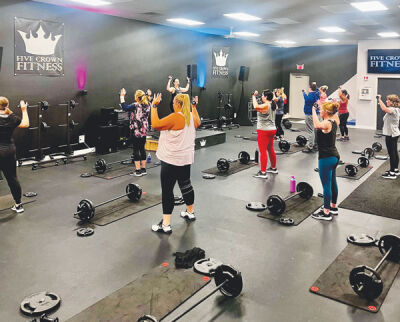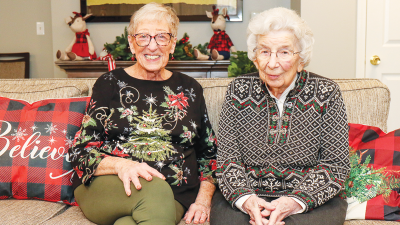
Exercising as part of a class or group can be one of the best ways to stay committed to a health goal in the new year.
Photo provided by Alexis Pacheco
METRO DETROIT — Getting in shape and losing a few pounds are common New Year’s resolutions, and local gym owners and trainers are sharing people’s goals, what techniques are popular and what they think is most effective.
Mona Mangen, the owner of Hotworx in Clawson and Plymouth, said that she’s seen an uptick in those looking for short, “heated” workouts.
“People are really loving the heated workouts,” she said. “It’s 125 degrees, but it’s a very dry heat. It’s short, but you get an intense sweat. People also feel like the one-on-one instructor feeling they get from things like a personal trainer really seems to help.”
Alexis Pacheco is a certified personal trainer, a health coach and the owner of Five Crown Fitness in Shelby Township. She said that she is seeing less heavy workouts and more of a focus on steady improvements and mindfulness.
“I think that people have been tracking steps. Because of the weather right now, which is a little abnormal, people are still walking either outside or on a treadmill. They want to get more movement in their day,” she said. “I think there’s an increase in wellness and mindfulness as a whole. People are seeking more opportunities for yoga and meditation as opposed to traditional strength training.”
Douglas Edwards, the director of the YMCA of Farmington Hills, said that many people are looking for group activities.
“I think the small group classes are a common thing we are seeing,” said Edwards. “The social aspect of older adults and meeting goals and staying in shape to not only get in shape but socialize also is very common right now.”
The desire for social activities is driving people back to the gym after COVID, something all three experts said is increasing membership and attendance numbers.
“Our usage is definitely up. During COVID, we had maybe 200 people daily,” said Edwards. “We are now up to about 600 people daily. Before the pandemic was probably between 600 and 800 people, depending on the time of year.”
“Per week, we are seeing about 100 to 150 people. It was about that point before COVID,” added Mangen. “Actually, we might be seeing a few more people than before COVID.”
Pacheco believes that most who were in the habit of working out never stopped, but now people are seeking more chances to get out and be with others in their workouts.
“I think it’s different than pre-pandemic levels,” she explained. “I think people are seeking community, so they are seeking more group settings. People who were accustomed to working out never stopped. They have developed more out of the Peloton era and now are focused more on groups or clubs. I think it’s very different than it was.”
While many are trying new avenues for health, many New Year’s resolutions still revolve around health-related goals, but sometimes in non-traditional ways.
“Overall health is important for a lot of people,” said Mangen. “We’re not seeing as many people setting weight goals, as opposed to general, more healthier living and lifestyle changes.”
“Some of the common resolutions are healthier food habits or losing a specific weight amount,” Edwards added. “Often we see people trying to team up with someone else as an accountability partner.”
Pacheco warned against untested trends and shortcuts, however.
“Weight loss is still the No. 1 goal,” she said. “There’s a lot of confusion about how to go about healthy weight loss. New and trending medications available have become popularized from celebrities. Especially with women, there’s a lot of confusion about weight loss. We still recommend traditional routes, such as increased movement, eating healthy, water intake, sleep and mindset.”
The biggest challenges for people in their health goals remain, it seems, staying committed to the initial goal in the new year.
“Accountability and consistency are always the biggest hurdles,” said Edwards. “About 60% of people fall off within 90 days of making their New Year’s resolutions. At The Y, we try to guide people so they stay in line with their aspirations for the whole year.”
“Staying consistent and remaining motivated are always the big ones,” agreed Mangen.
Pacheco also said the unrealistic goals can be something that causes people to give up on their resolutions, and she advises people to set more manageable milestones.
“I think the biggest struggle is unrealistic expectations because of things they see on social media and in our culture,” she said. “I used to be a coach for WeightWatchers, and the No. 1 thing that stopped people was trying to do too much at once and making massive changes that their body and mind weren’t ready for. There’s a much higher probability of self-sabotage if the effort you need to put in is too much.”
Edwards agreed that one of the best things someone trying to get in shape can do is to take small but steady steps.
“If you have a specific goal, think of it as a ladder with steps on it,” he said. “If the steps are too far apart from each other, you can’t reach the next step. Reasonable goals allow you to make this steady progress. Having an accountability partner is a big thing that helps too.”
“My advice would be to stay diligent and the weight will fall off,” agreed Mangen. “Getting to the gym is the hardest part for anybody.”
Pacheco said that one of the oldest and most tried and true methods is still the most effective: join a partner or group in health goals.
“Create reasonable expectations and engage with accountability partners, whether that’s a coach, a friend, a spouse, a group that meets regularly or so forth,” she said. “ It’s much easier and much more fun when accomplishing these goals as part of a group.”
 Publication select ▼
Publication select ▼















